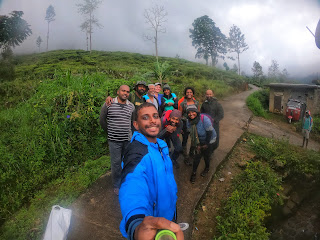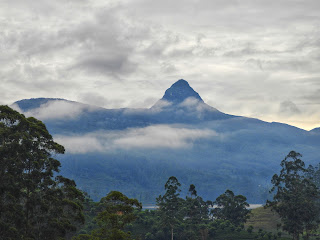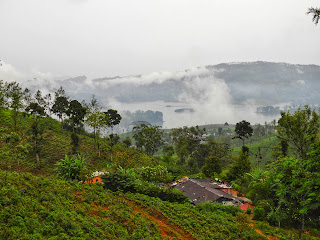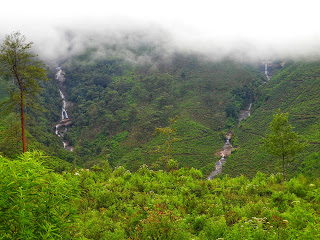Some of you may have heard of the legend of Gawara, an extinct mammal in Sri Lanka known by the scientific name of Bibos sinhaleyus. They belong to bovinae subfamily to which bison, yak, cattle and water buffalos belong to. The Ceylon Gaur was reported by several British writers since 1681 earliest being the writing of Robert Knox. Villages by the names Gawarammana”, “Gawara-eliya”, “Gawara-vila”, “Gawara-kele” and a grass species; “Gawara Maana” (Garnotia exaristata) which grows on highland plains are thought to have derived from this animal.
In January I went to experience
one of the villages, Gawara-vila with Summer Explorers on a “Leave No Trace” (LNT)
workshop. Let me explain what LNT means in simple words. The foundation of LNT
lies in sustainability. As the words imply, it is a sustainable way of
camping/hiking where the hikers follow 7 basic principles where the behaviour
is focused on minimizing the impact on the environment. These are:
- 1. Plan ahead and prepare
- 2. Travel and camp of durable surfaces
- 3. Dispose of waste properly
- 4. Leave what you find
- 5. Minimize campfire impacts
- 6. Respect wildlife
- 7. Be considerate of other visitors
Although the term LNT must be new
to you, the above principles I believe should be followed by any camper as it
is our duty to leave where we went as it is so that those come in future will also
have the similar experience like we did. So, the tour was important in two aspects,
the LNT workshop and the exploration of Gawarawila. Summer explorers had
already got the permissions from the relevant authorities as Gawarawila is
considered as sensitive ecosystem and is restricted to access by public.
We left Colombo on a Friday night
(earlier than what was planned) and reached Maskeliya by about 7 in the morning.
I have known Krishani (Co-founder of Summer Explorers) before, but this was the
first time we did a travel together. It was a pleasure meeting her and her
husband Sanka as well as some of my usual travel buddies since it was after a
long time due to Covid restrictions.
It was drizzling by the time we
reached Maskeliya. We freshen ourselves, had some tea, changed our clothes and had
our breakfast. Through the window of the shop, we could see Sri Pada at a distance.
During the preparation we got ourselves acquainted with the other travel
companions as everyone was sleeping during the journey to Maskeliya. We packed
our lunch. Something special to note is that all the lunchboxes and the cutlery
were disposable ones. This was another aspect of the sustainability that the
team was practicing.
We left the shop and drove to
Murray state where our hike was to begin. A guide from the village had been
arranged already. So, we packed our heavy stuff into a three-wheeler and put on
the day packs with the essentials. Krishani gave us a briefing on LNT and what
was expected. It was still drizzling when we began the hike. But that was a
blessing to take our weariness away.
We trekked through the village,
tea bushes. The Gartmore waterfall was visible from a distance. There were some
steep elevation gains during the first part. But later we were moving along a gradual
elevation. Be reached the point where the three-wheeler had bought our
belongings. So, we took the stuff from there and carried them along the rest of
the trek which took us about 45 minutes to reach the camping site.
The view and the climate were
amazing and soothing. As soon as we went to the camping site, we set up the tents
and had our lunch. It was relatively an easy hike or rather a trek. The lunch
gave us some energy. The camping site was near a stream, so it gave easy access
to water. It was getting bit darker, nevertheless we decided that we should do
the hike to Gawarawila planes. So again, we packed our essentials and started
moving. By the time we reached a stream which was a midway point, it was getting
bit darker. So, we decided to come back to the camping site and rest and to do
the hike on the following day morning.
There were some leaches. Bearable.
It was getting dark and cold. The girls changed themselves and went to have a
bath while the boys started to cook. Having the stream near was such a relief.
Me and Mahesh (another member of the team) tried to make a campfire. We tried
almost for an hour and finally gave up as the wood was so wet and it was windy.
As the dark approached, the cold
also followed it. Me and Sachintha (Another member) who shared the tent decided
to have a bath after we finished the cooking. It was pretty dark by the time
the cooking was done. We both changed and went into the water which was
relatively cold but bearable and had a bath. When we changed and came all were
having dinner. That was a wonderful dinner that was prepared by Sanka and the
team and after having it all went to tents to have a good night sleep with the hope
of getting up early to do the hike before the rains (Fortunately the rains went
away during the night)
The guide who came with us decided
to go back home as his children were alone. Sachintha was having a stomach problem
so he had some discomfort throughout the journey and night. It was relatively cold
at night. But we all had good night sleep with the bodies keeping us warm.
Almost everyone was awake early,
but most did not want to come out of tents. Sanka and Krishani were making tea.
When we finally came out of the tents, it was as if we were forcefully pulled
by the Mother Nature so that we do not miss the view. It was such a pleasant
view for the eyes. The green colour of the flora and the blue sky were soothing
both our bodies and minds. Having the morning coffee with this view was what I call
a WOW feeling that came with the package.
Even by the time our guide came back
with some Dhal curry, we were not at all prepared to go on the trail. We had a
quick breakfast. Sachintha became my tent partner, by bath partner and finally my
boga partner as well. We went up stream to find a good pooping spot. Did the
thing and came back. There were some beautiful orchids and the upstream was beautiful
and calm and my only regret was that I was not able to do some skinny dipping
there (Perhaps the next time).
Me and Rasika (Another member)
took some of the bags back to the three-wheeler which was waiting down. After a
quick breakfast, we started the hike to Gawarawila leaving Sanka and our guide
to clear the camping site and with the idea of meeting us at the planes.
The trek to Gawarawila I would
rate as an average hike. There were some steep climbs, slippery spots, leaches
and the ground was wet. We climbed in some drizzle. My only wish was by the
time we reach the planes, it will be clear without mist so that we can get a
good peak of the Sri Pada from there.
Finally, we reached the plane.
This was the moment I was waiting for almost 2 years. It was muddy like a marsh
due to rains. I do not know how to describe the view. It was as if a green
carpet was laid on land. It was an entire stretch of grass that extended as far
as our eyes could see. Luckily as we came there, there was no mist. But it was
beginning to drizzle and we could not spend as much time as we wished. We wanted
to go to the point where the waterfall fell (top of the waterfall) but as drizzling
was continuing and no one knew the exact route we decided to come back (which
is another thing which I would have to do the next time I come here).
We started coming back, met Sanka and our guide on the way and headed back to the camp site. From there we took an alternative route to the one we took to come. I am so glad that we took this path as although difficult it passed through some beautiful cascades of the waterfall. It took us a considerable time to reach the point where our van was waiting. We had a quick lunch and got into the van thinking of finding a place to have a bath.
After travelling for an hour or
so we found a beautiful spot by the road, where the seven virgins were visible
from the roadside. It was late evening. We had dinner, bid farewell to Sachintha
who took a bus to Nawalapitiya and continued our journey back to Colombo.
This was something that the Summer
Explorers planned during the Covid break. So, we had many restrictions. As a result,
we all were under a tight schedule, limited in travel and exploring. Though I went
to Gawarawila Planes, I personally felt that I did not experience it as I wish
I could. On another day I would have had a bath on all the streams I came
across. I would have spent more time roaming on the planes and even somehow
reach the top of the waterfall. But the circumstances were such that, we had to
abide by the time constraints, the covid situation and nature of the tour (As
it was a workshop and came under approvals from officials).
But this was an escape that I
have been wanting to have after months of not being in the wilderness. I met
friends that I had not met for months, learnt about LNT concepts and made it to
Gawarawila and spend a night in the nature. That was indeed some satisfaction.
But was it incomplete? Yes, it was. So, this is giving me room for another
visit hopefully on brighter more lighter circumstances.
I am thankful to Krishani and
Sanka of Summer Explorers for organizing this even amid such tight controls and
regulations. The team also should receive my appreciation for making the journey
enjoyable, comfortable, bearable and for many photographs taken that are
blueprints of the memories of the experience.
The author Anita Desai said “Wherever
you go becomes a part of you somehow”. Well even after many months passed from
the time, I visited Gawarawila, I still can recall the journey for me to write
to let you experience it through my words. This itself is a proof that Gawarawila
journey has indeed become a part of me and I’m sure even in another 10 years, I
would still recall the memories of this journey.
Thank you for reading and hope
you will remain safe.








































No comments:
Post a Comment